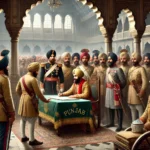PAK YATRA is a tour operator company providing tour services and facilitates Sikh community from different parts of the world.
Detailed History of Gurdwara Panjvin Patshahi:
Importance of the Place:
Gurdwara Panjvin Patshahi, located in the village of Chak Ram Das, holds significant historical and religious importance in Sikh heritage. It was built to commemorate a visit by the Fifth Guru, Guru Arjan Sahib Ji, to the area. The gurdwara served as a place of worship and spiritual gathering for the Sikh community until it fell into disrepair after the Partition.
Story Behind:
Guru Arjan Sahib Ji, the Fifth Guru of Sikhism, was drawn to the village of Chak Ram Das by the love and affection of his devoted follower, Bhai Prana. Impressed by the devotion of Bhai Prana and the local community, Guru Sahib visited the area, leaving behind a lasting legacy of spirituality and faith. A beautiful gurdwara was constructed in memory of Guru Sahib’s visit and the bond he shared with Bhai Prana and the villagers.
Location:
Chak Ram Das is situated in the Wandhu police station of the Gujranwala district, approximately 20 kilometers east of Eminabad. It lies along the Eminabad-Mianwali Bungalow road, making it accessible to devotees and visitors interested in exploring Sikh heritage sites.
Preservation Efforts:
Despite its historical significance, Gurdwara Panjvin Patshahi has suffered from neglect and lack of upkeep over the years. After the Partition and the ensuing communal violence, the local Sikh community migrated to the Indian part of Punjab for safety, leaving the gurdwara unattended. As a result, the gurdwara gradually fell into disrepair and disintegration. Currently, the custody of the land where the gurdwara once stood is under the Auqaf Department, highlighting the need for preservation efforts to protect this piece of Sikh heritage.
Architectural Marvel:
Gurdwara Panjvin Patshahi was once a beautiful architectural marvel, serving as a place of spiritual solace and community gathering. While specific details about its architectural features are not provided, the gurdwara’s significance lies in its historical and religious value to the Sikh community.
Historical Evolution:
The history of Gurdwara Panjvin Patshahi dates back to the visit of Guru Arjan Sahib Ji to the village of Chak Ram Das. Over time, the gurdwara became a center of religious worship and community service, attracting devotees from various regions. However, after the Partition and the subsequent migration of the Sikh community, the gurdwara’s decline began, leading to its eventual disintegration.
Background:
The establishment of Gurdwara Panjvin Patshahi was rooted in the deep spiritual connection between Guru Arjan Sahib Ji and his devotee, Bhai Prana, and the affection of the local Sikh community. The gurdwara served as a symbol of faith and devotion until it fell into neglect due to external circumstances and lack of maintenance.
Historical Significance:
Gurdwara Panjvin Patshahi holds immense historical significance as a site visited by Guru Arjan Sahib Ji, one of the revered Gurus of Sikhism. Its importance lies in its association with Guru Sahib’s teachings and the spiritual bond shared between Guru Sahib, Bhai Prana, and the Sikh community. Despite its current state of disrepair, the gurdwara remains a symbol of Sikh heritage and spirituality, underscoring the need for preservation efforts to safeguard its historical legacy.




